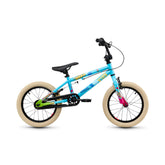Filter
5 results
20
- 10
- 15
- 20
- 25
- 30
- 50
Featured
- Featured
- Best selling
- Alphabetically, A-Z
- Alphabetically, Z-A
- Price, low to high
- Price, high to low
- Date, old to new
- Date, new to old
Sort
Sort by:
- Featured
- Best selling
- Alphabetically, A-Z
- Alphabetically, Z-A
- Price, low to high
- Price, high to low
- Date, old to new
- Date, new to old
-
DIKKA BMX 16" - Roll through the neighborhood
Yo, kids! The DIKKA BMX is a real blast! This cool bike is not only an eye-catcher, but also your faithful companion for all adventures. Whether it's tricks in the park or fast rides through the neighborhood, the DIKKA BMX is always ready. With sturdy tires and a robust frame, you're well equipped to show off your skills. Get on and experience the ultimate riding fun - Boom Schakkalakka!- 269,00 €
269,00 €- 269,00 €
- Unit price
- / per
-
S'COOL XtriX mini 16 inch 1-speed BMX
XtriX mini 16 inch 1-speed BMX Tricks like Superman and tabletop are possible with our XtriX models. Just the right BMX bike for the freestylers among you! NO PEGS INCLUDED!- 249,00 €
249,00 €- 249,00 €
- Unit price
- / per
-
DIKKA BMX 20" - Roll through the neighborhood
Yo, kids! The DIKKA BMX is a real blast! This cool bike is not only an eye-catcher, but also your faithful companion for all adventures. Whether it's tricks in the park or fast rides through the neighborhood, the DIKKA BMX is always ready. With sturdy tires and a robust frame, you're well equipped to show off your skills. Get on and experience the ultimate riding fun - Boom Schakkalakka!- 269,00 €
269,00 €- 269,00 €
- Unit price
- / per
-
S'COOL XtriX 20 1-speed BMX 20 inches
XtriX 20 1-speed BMX 20 inches The XtriX 20 is the entry-level model with a robust steel frame and axle pegs for your first freestyle adventures. Superman, Barspin, Tabletop - let's go!- 279,00 €
279,00 €- 279,00 €
- Unit price
- / per
-
Dark Green/Neon Green
-
Dark Grey/Orange
-
S'COOL XtriX 40 1-speed BMX 20 inches
XtriX 40 1-speed BMX 20 inches The XtriX 40 for advanced riders scores with a sturdy crank made of stainless CrMo steel, a CrMo frame, an extra high stem, soft lock-on handles, BMX U-brakes, Axel pegs and the single-speed hub with freewheel. This makes...- 399,00 €
399,00 €- 399,00 €
- Unit price
- / per
-
Purple/Fuchsia
-
Dark Grey/Beige


















